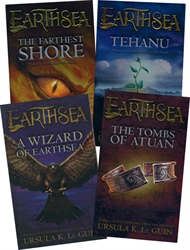

The narrative is powered by Ged’s vices and virtues, and this intertwining of character and plot gives A Wizard of Earthsea an inherent rightness, like a progression of unexpected yet satisfying chord changes. Each section of the novel is a stage in “Ged’s Progress”: from a village lout called Duny in Ten Alders, “wild, a thriving weed, a tall, quick boy, loud and proud and full of temper”, to an impatient apprentice at Re Albi, hungry for power for its own sake, to a brash student on Roke prone to inverted snobbery, to a chastened survivor on Low Torning and Pendor, to a guest in a trap on wintry Osskil, to a fugitive returning to Gont, and finally to a hunter going to his own death.


Where the Merlins reveal themselves layer by layer, Ged grows. Not to belittle TH White’s, Tolkien’s or Susan Cooper’s wizards (never belittle a wizard of any stripe), but they are variants on the archetype of Merlin, a Caucasian scholarly aristocrat amongst sorcerers, who appears fully formed and with little room for character development. He was by far the easiest wizard to relate to, and the least derivative I knew. Ged is a superb creation, by any measure, and was the Archmage of my bookshelf even before he became the Archmage of Earthsea. Adulthood brings more demanding critical standards and many a childhood favourite has been booted off my podium of most cherished books, but my admiration for Le Guin’s artistry has only grown with every rereading.įirst, there is the titular wizard himself. I yearned to do to other people what A Wizard of Earthsea had just done to me – even if I couldn’t articulate exactly what that was.

Growing up, I adored A Wizard of Earthsea, Le Guin’s slim but muscular 1968 novel, which I read and reread until my ratty old paperback copy required emergency surgery, and I still have a precious memory of getting to the last page for the umpteenth time, staring at the final line – “and Yarrow ran to meet them, crying with joy” – and realising with a giddy clarity that being a goalkeeper or inventor or forester was yesterday’s news, and that I had to be a writer and nothing else would do. Other magicians and witches also lived on my boyhood bookshelf, but even at 10 years old I sensed that these belonged to a lesser order. These were, in order of discovery, TH White’s Merlin, JRR Tolkien’s Gandalf, Susan Cooper’s Merriman Lyon and Ursula K Le Guin’s Ged, more commonly known as Sparrowhawk, true names being a serious business in Earthsea. F our principal wizards inhabited my childhood.


 0 kommentar(er)
0 kommentar(er)
